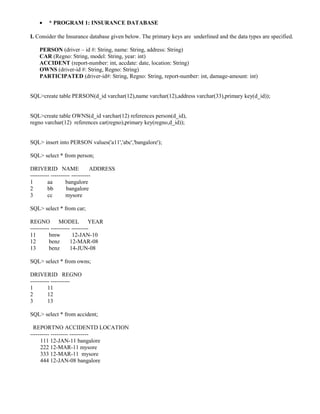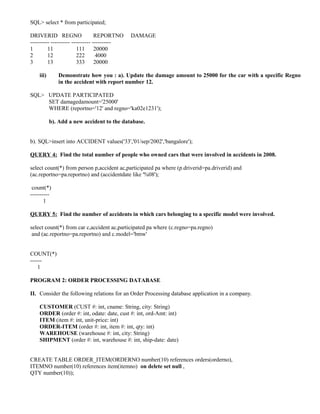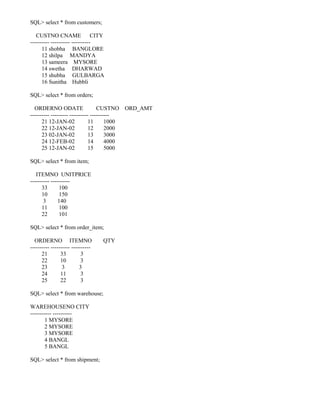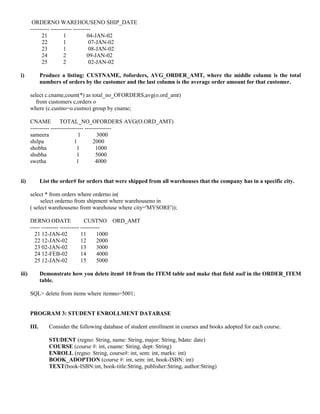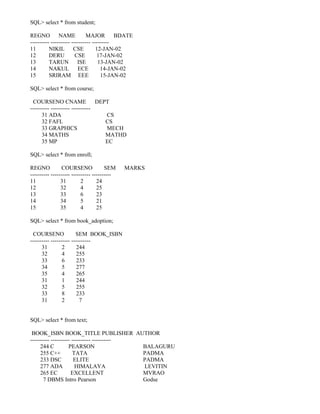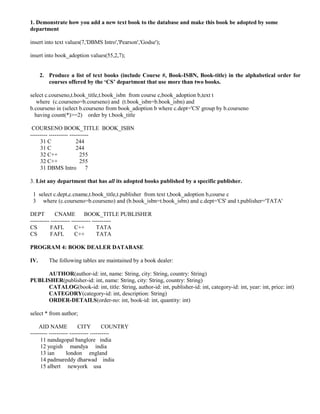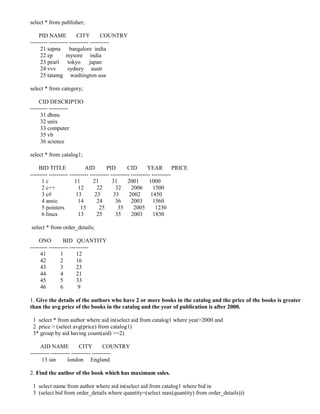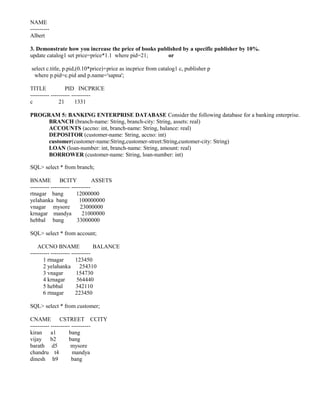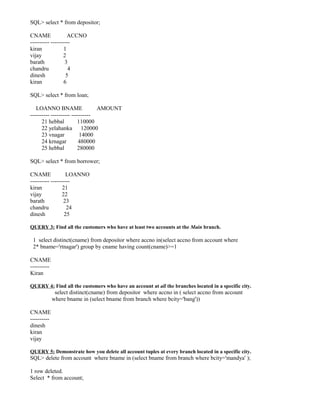Sql queries
- 1. ? * PROGRAM 1: INSURANCE DATABASE I. Consider the Insurance database given below. The primary keys are underlined and the data types are specified. PERSON (driver ĻC id #: String, name: String, address: String) CAR (Regno: String, model: String, year: int) ACCIDENT (report-number: int, accdate: date, location: String) OWNS (driver-id #: String, Regno: String) PARTICIPATED (driver-id#: String, Regno: String, report-number: int, damage-amount: int) SQL>create table PERSON(d_id varchar(12),name varchar(12),address varchar(33),primary key(d_id)); SQL>create table OWNS(d_id varchar(12) references person(d_id), regno varchar(12) references car(regno),primary key(regno,d_id)); SQL> insert into PERSON values('a11','abc','bangalore'); SQL> select * from person; DRIVERID NAME ADDRESS ---------- ---------- ---------- 1 aa bangalore 2 bb bangalore 3 cc mysore SQL> select * from car; REGNO MODEL YEAR ---------- ---------- --------- 11 bmw 12-JAN-10 12 benz 12-MAR-08 13 benz 14-JUN-08 SQL> select * from owns; DRIVERID REGNO ---------- ---------- 1 11 2 12 3 13 SQL> select * from accident; REPORTNO ACCIDENTD LOCATION ---------- --------- ---------- 111 12-JAN-11 bangalore 222 12-MAR-11 mysore 333 12-MAR-11 mysore 444 12-JAN-08 bangalore
- 2. SQL> select * from participated; DRIVERID REGNO REPORTNO DAMAGE ---------- ---------- ---------- ---------- 1 11 111 20000 2 12 222 4000 3 13 333 20000 iii) Demonstrate how you : a). Update the damage amount to 25000 for the car with a specific Regno in the accident with report number 12. SQL> UPDATE PARTICIPATED SET damagedamount='25000' WHERE (reportno='12' and regno='ka02e1231'); b). Add a new accident to the database. b). SQL>insert into ACCIDENT values('33','01/sep/2002','bangalore'); QUERY 4: Find the total number of people who owned cars that were involved in accidents in 2008. select count(*) from person p,accident ac,participated pa where (p.driverid=pa.driverid) and (ac.reportno=pa.reportno) and (accidentdate like '%08'); count(*) ---------- 1 QUERY 5: Find the number of accidents in which cars belonging to a specific model were involved. select count(*) from car c,accident ac,participated pa where (c.regno=pa.regno) and (ac.reportno=pa.reportno) and c.model='bmw' COUNT(*) ------ 1 PROGRAM 2: ORDER PROCESSING DATABASE II. Consider the following relations for an Order Processing database application in a company. CUSTOMER (CUST #: int, cname: String, city: String) ORDER (order #: int, odate: date, cust #: int, ord-Amt: int) ITEM (item #: int, unit-price: int) ORDER-ITEM (order #: int, item #: int, qty: int) WAREHOUSE (warehouse #: int, city: String) SHIPMENT (order #: int, warehouse #: int, ship-date: date) CREATE TABLE ORDER_ITEM(ORDERNO number(10) references orders(orderno), ITEMNO number(10) references item(itemno) on delete set null , QTY number(10));
- 3. SQL> select * from customers; CUSTNO CNAME CITY ---------- ---------- ---------- 11 shobha BANGLORE 12 shilpa MANDYA 13 sameera MYSORE 14 swetha DHARWAD 15 shubha GULBARGA 16 Sunitha Hubbli SQL> select * from orders; ORDERNO ODATE CUSTNO ORD_AMT ---------- --------- ---------- ---------- 21 12-JAN-02 11 1000 22 12-JAN-02 12 2000 23 02-JAN-02 13 3000 24 12-FEB-02 14 4000 25 12-JAN-02 15 5000 SQL> select * from item; ITEMNO UNITPRICE ---------- ---------- 33 100 10 150 3 140 11 100 22 101 SQL> select * from order_item; ORDERNO ITEMNO QTY ---------- ---------- ---------- 21 33 3 22 10 3 23 3 3 24 11 3 25 22 3 SQL> select * from warehouse; WAREHOUSENO CITY ----------- ---------- 1 MYSORE 2 MYSORE 3 MYSORE 4 BANGL 5 BANGL SQL> select * from shipment;
- 4. ORDERNO WAREHOUSENO SHIP_DATE ---------- ----------- --------- 21 1 04-JAN-02 22 1 07-JAN-02 23 1 08-JAN-02 24 2 09-JAN-02 25 2 02-JAN-02 i) Produce a listing: CUSTNAME, #oforders, AVG_ORDER_AMT, where the middle column is the total numbers of orders by the customer and the last column is the average order amount for that customer. select c.cname,count(*) as total_no_OFORDERS,avg(o.ord_amt) from customers c,orders o where (c.custno=o.custno) group by cname; CNAME TOTAL_NO_OFORDERS AVG(O.ORD_AMT) ---------- ----------------- -------------- sameera 1 3000 shilpa 1 2000 shobha 1 1000 shubha 1 5000 swetha 1 4000 ii) List the order# for orders that were shipped from all warehouses that the company has in a specific city. select * from orders where orderno in( select orderno from shipment where warehouseno in ( select warehouseno from warehouse where city='MYSORE')); DERNO ODATE CUSTNO ORD_AMT ----- --------- ---------- ---------- 21 12-JAN-02 11 1000 22 12-JAN-02 12 2000 23 02-JAN-02 13 3000 24 12-FEB-02 14 4000 25 12-JAN-02 15 5000 iii) Demonstrate how you delete item# 10 from the ITEM table and make that field null in the ORDER_ITEM table. SQL> delete from items where itemno=5001; PROGRAM 3: STUDENT ENROLLMENT DATABASE III. Consider the following database of student enrollment in courses and books adopted for each course. STUDENT (regno: String, name: String, major: String, bdate: date) COURSE (course #: int, cname: String, dept: String) ENROLL (regno: String, course#: int, sem: int, marks: int) BOOK_ADOPTION (course #: int, sem: int, book-ISBN: int) TEXT(book-ISBN:int, book-title:String, publisher:String, author:String)
- 5. SQL> select * from student; REGNO NAME MAJOR BDATE ---------- ---------- ---------- --------- 11 NIKIL CSE 12-JAN-02 12 DERU CSE 17-JAN-02 13 TARUN ISE 13-JAN-02 14 NAKUL ECE 14-JAN-02 15 SRIRAM EEE 15-JAN-02 SQL> select * from course; COURSENO CNAME DEPT ---------- ---------- ---------- 31 ADA CS 32 FAFL CS 33 GRAPHICS MECH 34 MATHS MATHD 35 MP EC SQL> select * from enroll; REGNO COURSENO SEM MARKS ---------- ---------- ---------- ---------- 11 31 2 24 12 32 4 25 13 33 6 23 14 34 5 21 15 35 4 25 SQL> select * from book_adoption; COURSENO SEM BOOK_ISBN ---------- ---------- ---------- 31 2 244 32 4 255 33 6 233 34 5 277 35 4 265 31 1 244 32 5 255 33 8 233 31 2 7 SQL> select * from text; BOOK_ISBN BOOK_TITLE PUBLISHER AUTHOR ---------- ---------- ---------- ---------- 244 C PEARSON BALAGURU 255 C++ TATA PADMA 233 DSC ELITE PADMA 277 ADA HIMALAYA LEVITIN 265 EC EXCELLENT MVRAO 7 DBMS Intro Pearson Godse
- 6. 1. Demonstrate how you add a new text book to the database and make this book be adopted by some department insert into text values(7,'DBMS Intro','Pearson','Godse'); insert into book_adoption values(55,2,7); 2. Produce a list of text books (include Course #, Book-ISBN, Book-title) in the alphabetical order for courses offered by the ĄŪCSĄŊ department that use more than two books. select c.courseno,t.book_title,t.book_isbn from course c,book_adoption b,text t where (c.courseno=b.courseno) and (t.book_isbn=b.book_isbn) and b.courseno in (select b.courseno from book_adoption b where c.dept='CS' group by b.courseno having count(*)>=2) order by t.book_title COURSENO BOOK_TITLE BOOK_ISBN --------- ---------- ---------- 31 C 244 31 C 244 32 C++ 255 32 C++ 255 31 DBMS Intro 7 3. List any department that has all its adopted books published by a specific publisher. 1 select c.dept,c.cname,t.book_title,t.publisher from text t,book_adoption b,course c 3 where (c.courseno=b.courseno) and (b.book_isbn=t.book_isbn) and c.dept='CS' and t.publisher='TATA' DEPT CNAME BOOK_TITLE PUBLISHER ---------- ---------- ---------- ---------- CS FAFL C++ TATA CS FAFL C++ TATA PROGRAM 4: BOOK DEALER DATABASE IV. The following tables are maintained by a book dealer: AUTHOR(author-id: int, name: String, city: String, country: String) PUBLISHER(publisher-id: int, name: String, city: String, country: String) CATALOG(book-id: int, title: String, author-id: int, publisher-id: int, category-id: int, year: int, price: int) CATEGORY(category-id: int, description: String) ORDER-DETAILS(order-no: int, book-id: int, quantity: int) select * from author; AID NAME CITY COUNTRY --------- ---------- ---------- ---------- 11 nandagopal banglore india 12 yogish mandya india 13 ian london england 14 padmareddy dharwad india 15 albert newyork usa
- 7. select * from publisher; PID NAME CITY COUNTRY --------- ---------- ---------- ---------- 21 sapna bangalore india 22 ep mysore india 23 pearl tokyo japan 24 vvv sydney austr 25 tatamg washington usa select * from category; CID DESCRIPTIO --------- ---------- 31 dbms 32 unix 33 computer 35 vb 36 science select * from catalog1; BID TITLE AID PID CID YEAR PRICE --------- ---------- ---------- ---------- ---------- ---------- ---------- 1c 11 21 31 2001 1000 2 c++ 12 22 32 2006 1500 3 c# 13 23 33 2002 1450 4 ansic 14 24 36 2003 1560 5 pointers 15 25 35 2005 1230 6 linux 13 25 35 2003 1830 select * from order_details; ONO BID QUANTITY --------- ---------- ---------- 41 1 12 42 2 16 43 3 23 44 4 21 45 5 33 46 6 9 1. Give the details of the authors who have 2 or more books in the catalog and the price of the books is greater than the avg price of the books in the catalog and the year of publication is after 2000. 1 select * from author where aid in(select aid from catalog1 where year>2000 and 2 price > (select avg(price) from catalog1) 3* group by aid having count(aid) >=2) AID NAME CITY COUNTRY ---------- ---------- ---------- ---------- 13 ian london England 2. Find the author of the book which has maximum sales. 1 select name from author where aid in(select aid from catalog1 where bid in 3 (select bid from order_details where quantity=(select max(quantity) from order_details)))
- 8. NAME ---------- Albert 3. Demonstrate how you increase the price of books published by a specific publisher by 10%. update catalog1 set price=price*1.1 where pid=21; or select c.title, p.pid,(0.10*price)+price as incprice from catalog1 c, publisher p where p.pid=c.pid and p.name='sapna'; TITLE PID INCPRICE ---------- ---------- ---------- c 21 1331 PROGRAM 5: BANKING ENTERPRISE DATABASE Consider the following database for a banking enterprise. BRANCH (branch-name: String, branch-city: String, assets: real) ACCOUNTS (accno: int, branch-name: String, balance: real) DEPOSITOR (customer-name: String, accno: int) customer(customer-name:String,customer-street:String,customer-city: String) LOAN (loan-number: int, branch-name: String, amount: real) BORROWER (customer-name: String, loan-number: int) SQL> select * from branch; BNAME BCITY ASSETS ---------- ---------- ---------- rtnagar bang 12000000 yelahanka bang 100000000 vnagar mysore 23000000 krnagar mandya 21000000 hebbal bang 33000000 SQL> select * from account; ACCNO BNAME BALANCE ---------- ---------- ---------- 1 rtnagar 123450 2 yelahanka 254310 3 vnagar 154730 4 krnagar 564440 5 hebbal 342110 6 rtnagar 223450 SQL> select * from customer; CNAME CSTREET CCITY ---------- ---------- ---------- kiran a1 bang vijay b2 bang barath d5 mysore chandru t4 mandya dinesh h9 bang
- 9. SQL> select * from depositor; CNAME ACCNO ---------- ---------- kiran 1 vijay 2 barath 3 chandru 4 dinesh 5 kiran 6 SQL> select * from loan; LOANNO BNAME AMOUNT ---------- ---------- ---------- 21 hebbal 110000 22 yelahanka 120000 23 vnagar 14000 24 krnagar 480000 25 hebbal 280000 SQL> select * from borrower; CNAME LOANNO ---------- ---------- kiran 21 vijay 22 barath 23 chandru 24 dinesh 25 QUERY 3: Find all the customers who have at least two accounts at the Main branch. 1 select distinct(cname) from depositor where accno in(select accno from account where 2* bname='rtnagar') group by cname having count(cname)>=1 CNAME ---------- Kiran QUERY 4: Find all the customers who have an account at all the branches located in a specific city. select distinct(cname) from depositor where accno in ( select accno from account where bname in (select bname from branch where bcity='bang')) CNAME ---------- dinesh kiran vijay QUERY 5: Demonstrate how you delete all account tuples at every branch located in a specific city. SQL> delete from account where bname in (select bname from branch where bcity='mandya' ); 1 row deleted. Select * from account;
